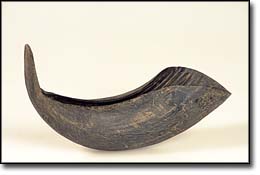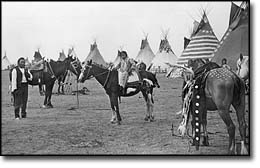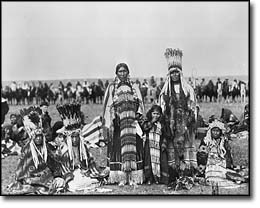 |
Fact Sheet |
The Blackfoot Way of Life
Exhibition Themes
The exhibition sheds light on many aspects of the traditional Blackfoot way of life, and illustrates the depth and richness of Blackfoot culture and traditions.
Food: The importance of preservation
Meat brought to camp was cured as quickly as possible and prepared for cooking and preserving. A primary method of food preservation was to dry meat by cutting it into thin strips, which they then hung in the sun. The dried meat was then stored in rawhide containers, along with dried mint to keep the bugs away. In the fall, fat was added to a mixture of crushed dried berries and dried meat to create moki-maani (pemmican). Moki-maani would often keep the people from starving during the winter.
|
Spoon from the Plains; 1940s Buffalo horn 33 cm (L) x 6.5 cm (W) Glenbow Museum Collection, Calgary, Canada AF 4066 |

|
Children's education: A shared responsibility
Traditionally, the Blackfoot camped in clans, with the women caring for the newborn. A few months after the birth of a child, parents approached a respected adult to name the newborn. This name, which reflected the achievements of the respected individual, would bring the child blessings and success. The Blackfoot people still name their children in this way.
The Blackfoot would watch their children's development with care and patience. Children were allowed to develop their natural abilities, without much interference from adults. When children misbehaved, they were disciplined by their aunts and uncles. Physical punishment was rare and was used only when all other means failed.
Tipis: The perfect home for the Prairies
Perfectly adapted to the windy Prairies, tipis were traditionally made with hides and later from canvas and were used for shelter, sleeping and ceremonies. Easily transported, the Blackfoot would carry their tipis using travois made from lodgepole pine and willow. The stunning images on tipis are far more than decorative: they are meant to connect the people with the Spirit Beings. The right to use any of the designs is a privilege that must be formally recognized in a ceremony.

|
Blood Camp near Lethbridge, Alberta, n.d. Glenbow Archives NA 670-30 |
Men and women: Living and working together
Ancient Blackfoot stories describe how men and women had different, but complementary roles in society. They operated on a strong principle of mutual respect and support, and understood how much they depended on each other for survival. Men were often away from camp to hunt or protect the territory, while women's roles were centred on the camp, carrying out essential tasks such as preparing dried meat, tanning hides and sewing clothes and tipi covers.
The buffalo: The hunt for survival
The Blackfoot often hunted buffalo – either solitary animals or those in small herds – quietly surrounding the animals before making the kill. In the past, pisskan, or buffalo jumps, were an important method used in hunting. The Blackfoot would lure herds of bison toward steep cliffs, killing hundreds of animals at a time. Using a pisskan was complicated, difficult and dangerous, and required the coordinated effort of people from many clans.
|
Saddle from the Plains; late 1800s Wood, sinew, rawhide, brass buttons, buckskin, steel, leather, deer antlers 31 cm (H) x 43.5 cm (L) x 27 cm (W) Glenbow Museum Collection, Calgary, Canada AF 5127 |

|
Spiritual life: Everything is sacred
For the Blackfoot people, everything in their world is sacred. Therefore, it is essential for them to acknowledge the Creator and the Spirit Beings. Each year, Blackfoot clans come together to renew their connection with their universe at a spiritual gathering called ako-katssin ("the time of all people camping together"). These gatherings can last up to three weeks. Central to the gathering is ookaan, a ceremony in which the people renew their connection to Natosi, the sun and giver of life.
This is also the time when members of Sacred Societies meet and hold ceremonies that recall how the sacred bundles and rituals were given to the Blackfoot people. Sacred bundles contain objects given to the Blackfoot by the Spirit Beings. These bundles are used in ceremonies to renew the connections with the Spirit Beings and Creator, and to ask for help. Both the sacred bundles and the ceremonies are considered to be private.
Social dances: From small gatherings to powwows
Dancing has always been an important part of socializing for the Blackfoot. People often hosted round dances, owl dances and snake dances in their homes. On more formal occasions, they would gather in community halls. Today, most Blackfoot social dancing is done at powwows where people from many nations gather together and celebrate their Aboriginal heritage through dance, music and song. The dance styles seen today come from different regions of North America. The Men's Buckskin, Women's Traditional and Chicken Dance are originally from the Blackfoot territory.

|
Blackfoot groups during the 1901 Royal Visit Glenbow Archives NA539-2 Library and Archives Canada PA 381-10 |
Backgrounder | Exhibition themes | Communiqué